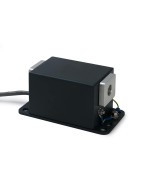MWDS - Metal Wear Debris Sensor
It's no secret that particles result from wear. It is imperative to know, not just the number of particles which pass through your system, but also the size and metallic composition. The Parker Kittiwake Metallic Wear Debris Sensor goes beyond normal protection systems, allowing you to monitor in real time and take immediate action on the first indication of change, thereby preventing all types of failure.
The Kittiwake Metallic Wear Debris Sensor can be mounted within almost any lubrication system, on any type of machine. By using proven inductive coil technology, combined with smart algorithms to provide a particle size distribution count, the sensor measures ferrous and non-ferrous metals resulting from the wear debris within the lubricant. This puts the user in control. The severity of the problem increases with an escalation in the production of larger wear debris particles.
With both digital and analogue outputs, the sensor can be easily integrated into existing condition monitoring control systems, putting the user in control. Whether it's checking the health of the machine or alerting to changing wear patterns, the sensor provides instant information, complementing existing laboratory oil analysis programmes and helping the user make informed maintenance planning decisions.
The Kittiwake Metallic Wear Debris Sensor can be mounted within almost any lubrication system, on any type of machine. By using proven inductive coil technology, combined with smart algorithms to provide a particle size distribution count, the sensor measures ferrous and non-ferrous metals resulting from the wear debris within the lubricant. This puts the user in control. The severity of the problem increases with an escalation in the production of larger wear debris particles.
With both digital and analogue outputs, the sensor can be easily integrated into existing condition monitoring control systems, putting the user in control. Whether it's checking the health of the machine or alerting to changing wear patterns, the sensor provides instant information, complementing existing laboratory oil analysis programmes and helping the user make informed maintenance planning decisions.



